It was ultra-high summer, and it was difficult sailing in Dublin Bay for the hugely varied fleet starting their racing in the Volvo Dun Laoghaire Regatta 2019 writes W M Nixon. Today’s opening racing started with so much promise – a sparkling sunlit westerly and the race area enlivened by the flood tide. But as the afternoon settled in, the breeze went to sleep, and when a new easterly finally decided to come creeping in under a soft grey sky, it did so in a very uneven way, as was shown in the results for the IRC Classes.
For although the glamour boats of Classes 0, 1 and 2 were in the Race Area nearest the smooth opulence of Dublin Bay’s southeast coast, it was the smaller craft exiled to the middle of the bay – virtually the Northside as some true blue Dun Laoghaire types saw it – who had the best of the day’s sailing, as the new wind nipped in round the Baily with some determination, whereas it was decidedly languid as it wandered in past the Muglins and Dalkey Island.
 The J109 Outrajeous is the first to set her kite on the opening 'beat' when the wind shifts just minutes into race one. The race was abandoned. Photo: Afloat
The J109 Outrajeous is the first to set her kite on the opening 'beat' when the wind shifts just minutes into race one. The race was abandoned. Photo: Afloat
In other words, the biggies completed just one race, but the little ‘uns got in two. In Class 0, Jamie McWilliam’s Ker 40 Signal 8 from Hong Kong looked like she could fly given a wind, but for some time there weren’t no wind at all at all to ruffle the hair-styles of Dalkey, and it was Frank Whelan’s achingly consistent Grand Soleil 44 Eleuthera from Greystones which started from where she’d left off at Kinsale by taking the bullet, while second went to Conor Phelan’s Ker 36 Jump Juice from Crosser, but Signal 8 still made the podium with the third.
 Jamie McWilliam's Ker 40, Signal 8 Photo: Afloat
Jamie McWilliam's Ker 40, Signal 8 Photo: Afloat
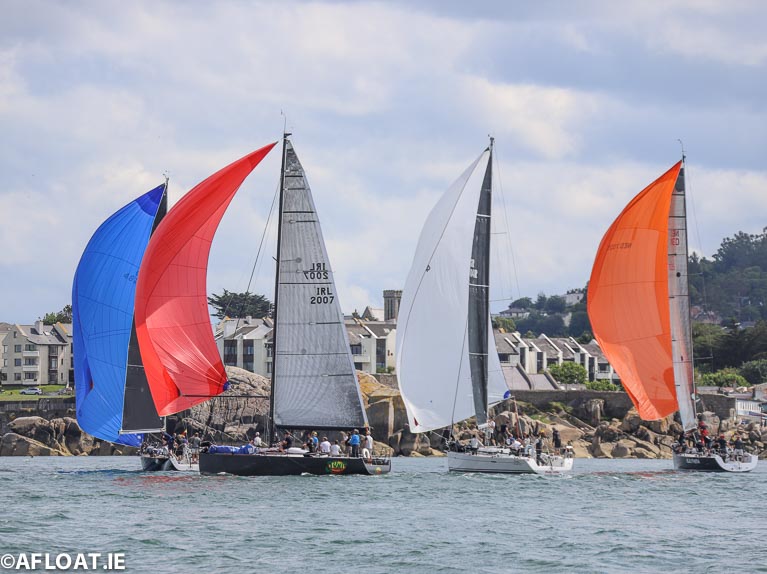 A tightly grouped Class Zero off Bulloch Harbour just before the wind died in aborted race one Photo: Afloat
A tightly grouped Class Zero off Bulloch Harbour just before the wind died in aborted race one Photo: Afloat
IRC 1 was a truly awesome turnout in terms of number, but as far as wind speeds were concerned, the numbers suited the J/109s very well indeed, thank you, and they took eight of the first ten places, with the John Maybury’s Joker 2 (RIYC) getting the best of it from clubmates Tim & Richard Goodbody in White Mischief, third place going to Pat Kelly’s Storm from Howth and Rush while longtime J/109 advocates Brian & John Hall (NYC) were fourth with Something Else.
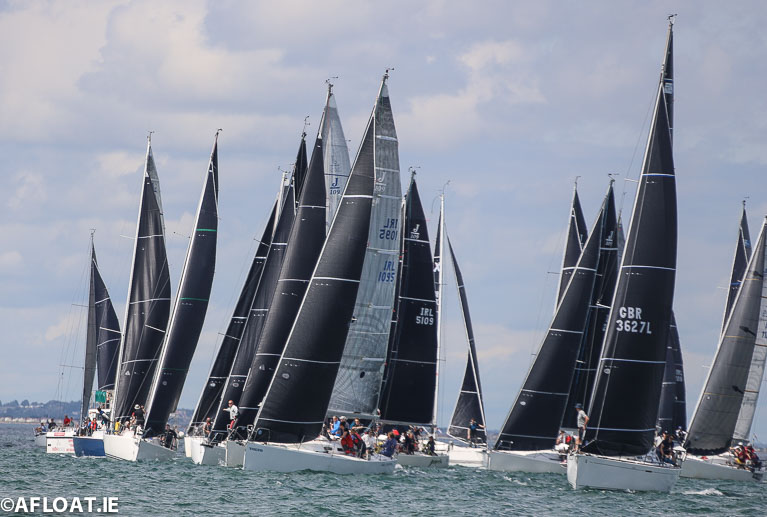 A Class One Start Photo: Afloat
A Class One Start Photo: Afloat
The RC 35 Division was within IRC 1, and here the winner was Storm with Something Else second and Robin Young’s Jings from Scotland – yet another J/109 – taking third.
Coastal Division
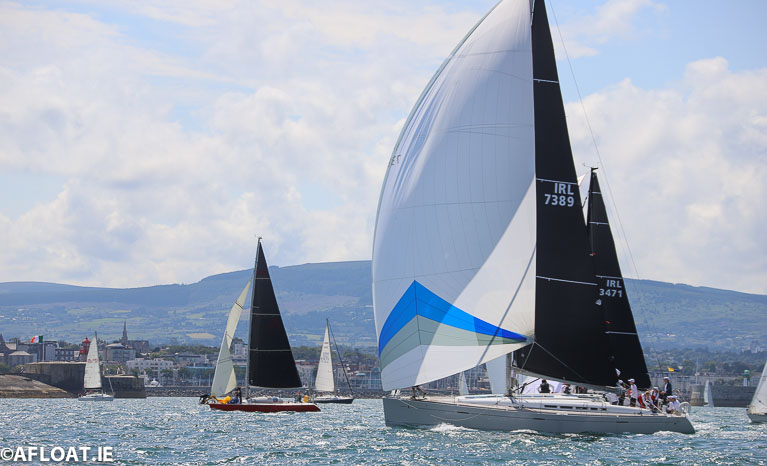 Seamus Fitzpatrick’s big Beneteau First 50 Mermaid IV clears the harbour mouth at the start of the race Photo: Afloat
Seamus Fitzpatrick’s big Beneteau First 50 Mermaid IV clears the harbour mouth at the start of the race Photo: Afloat
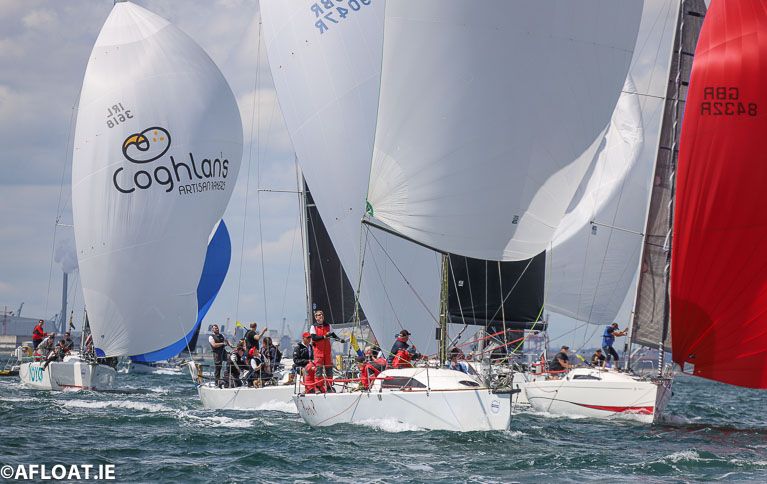 The start of the coastal class race with Fintan Cairns's Raptor closest to camera Photo: Afloat
The start of the coastal class race with Fintan Cairns's Raptor closest to camera Photo: Afloat
Meanwhile the 30 boats which had gone offshore in the coastal race finally managed to find their way to a finish, and it was Seamus Fitzpatrick’s handsome big Beneteau First 50 Mermaid IV (RIYC) – with former All-Ireland Sailing Champion Ben Duncan as tactician - which managed to stave off the challenge of Andrew Hall’s slippery J/125 Jackknife from Pwllheli in second, third place going to George Sisk (RIYC) with his Xp44 WOW.
 JackKnife follows Wow out of Dublin Bay at the start of an 18-mile coastal race Photo: Afloat
JackKnife follows Wow out of Dublin Bay at the start of an 18-mile coastal race Photo: Afloat
By comparison with the frustrated big fellows, IRC 3 out in mid-bay had themselves a heady time of it with two races completed, and it was Charlie McAllister’s Starflash Quarter Tonner Fait Accompli from Antrim Boat Club on Lough Neagh which took to the salty sea with relish, and emerged top of the day’s racing with a 1st and a 3rd, Ger O’Sullivan’s Formula 28 Animal from Howth being next best with a 5th and a 1st, while third overall was taken by Ken Lawless’s Quarter Tonner Cartoon (RIYC) with a 4th and 2nd.
Perhaps the most impressive aspect of the IRC racing is the sheer size of the class numbers involved. If the fates decide to give us enough breeze tomorrow to provide racing, we’ll look in more detail at some other sides to this varied and complex story. But for now, the miracle is that with the awkward wind pattern, the Race Officers still managed to get in a programme, we have results, and tomorrow is another day.
Division 2a details are here
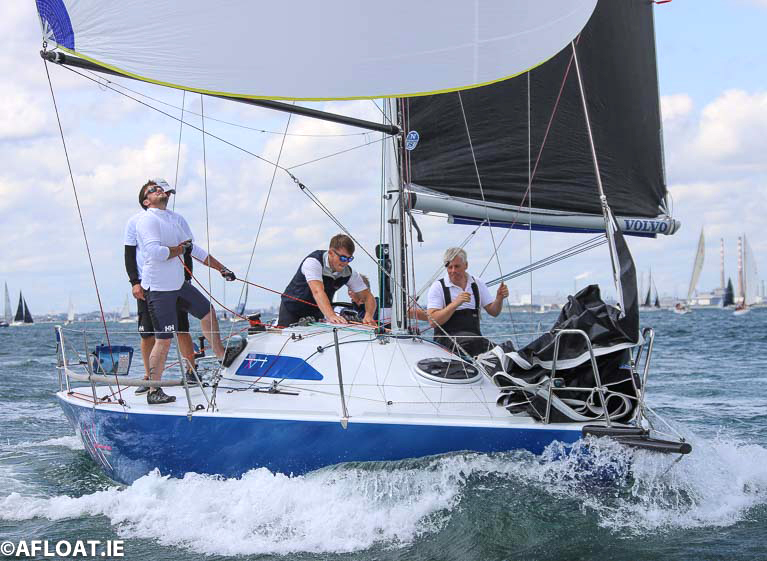 Dave Cullen's Checkmate XV is competing in class Two Photo: Afloat
Dave Cullen's Checkmate XV is competing in class Two Photo: Afloat






























































